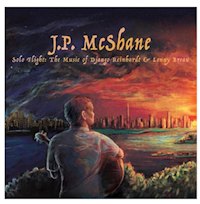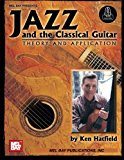Classical Guitar, Jazz and Melancholy 
J.P. offered to send me his CD entitled Solo Flight for review on my website. It is Jazz but he uses classical guitars to play it.
This section of my website focuses on the classical guitar, and almost exclusively I cover the traditional music of the classical guitar but I thought it would be great to hear some of the potential that is within the classical guitar in different genres of music. After all, it was Segovia who said: "The Guitar is a little orchestra. You can get a great deal from it."
And this brings me to the title of my review: Classical Guitar, Jazz, and Melancholy.
The traditional classical guitar tends to be almost mathematical. It is beautiful, rich and pleasant. It does a lot of things but emotional expression is not high on the list. This is partially due to it's roots in religious and baroque music. And partly due to it's role within an orchestra.
And the subtleties of emotional expression are extremely varied. When we think of the feeling of melancholy can we come up with a traditional classical guitar piece that covers it? There are a few, but not many. The Agustin Barrios piece "Preludio Saudade" from La Catedral does come to mind. Ahhh... but when you move into the realm of Jazz music you can come up with lots of examples of that feeling and of many other expressions and feelings. I might dare to say that classical music tends toward right brain and Jazz tends toward left brain.
But the classical guitar as an instrument doesn't know boundaries. It can move across a whole spectum, just as Segovia knew.
And this is what J.P. McShane does in this CD. He uses the classical guitar to express that subtle feeling of melancholy. But I don't mean melancholy in the extreme form of the word as a sadness. I mean it more like a yearning, a saudade for something. It is a subtle feeling like you might get looking out a window on a rainy day. It's-a beautiful-world kind of melancholy.
The cover art for the CD expresses this well. And there probably is no better way to start out a CD like this than with the Mancini song The Days of Wine and Roses . It is the first track and it sets up the mood for us.
The Days of wine and roses laugh and runaway like a child at play,
through the meadowland toward a closing door,
a door marked "Nevermore" that wasn't there before.
The lonely night discloses just a passing breeze filled with memories
of the golden smile that introduced me to the Days of Wine and Roses and you.
Days of Wine and Roses is a Jazz standard written by Henry Mancini and recorded/arranged by many performers including Lenny Breau.
And the genres
Just as I wanted to explore the potential for classical guitar in other rivers of music J.P. also takes this same tact. He explores it in different genres through a jazz lens. This can be felt in tracks like track 3 "Batucada" orignally written by
Luis Bonfá.
and is a Brazilian love song.
Let's expand this feeling and theme out to the rest of the world. And this is where the quote by Segovia continues to be proven. Another track on the CD is Celtic Dream Stream, a piece originally written by Lenny Breau. It is another subtle piece that expresses Saudade through the classical guitar and the phrasings of Celtic Music.
Another piece is New York City (track 5). It also has that feeling except with a New York City approach. It features Jaclyn Taylor as the singer.
In total there are ten tracks on the CD. I have talked about the first five. The final five tracks are improvisations. And this is where we as classical guitarists can learn the most from Jazz. I talked about how right brain emotional expression is subdued in classical guitar and this is even more so when it comes to improvisation. When was the last time you read a piece of sheet music that called for an improvisation?
In review
It is a good CD, full of subtle feelings that are expressed over a wide range of genres. If you want to learn more about expression, jazz, improvisation and the potential of the classical guitar I recommend you get it! I have a link to it on amazon below. There you can sample it or buy the cd or even buy single tracks.
RESOURCES

The CD is available on Amazon.com right here: Solo Flight: The Music of Django Reinhardt and Lenny Breau
Guitar Resources: In the liner notes J.P. Gives credit to Guitars by Gil Carnal and Kenny Hill. (The Kenny Hill website is currently unaccessible)
 Jazz and the Classical Guitar: Theory and Application Jazz and the Classical Guitar: Theory and Application
This book is designed to familiarize classical guitarists with the musical vocabulary of jazz, and to encourage jazz guitarists to explore the beautiful sonorities and limitless expressive potential of the classical guitar. The first half of the book contains theoretical explanations focused on harmonic analysis of the types of chord changes and song forms one routinely encounters in the jazz repertoire, as it demonstrates the application of all twelve notes of the chromatic scale to any chord in any situation. The second half of the book is comprised of Ken Hatfield's original compositions and transcriptions of his improvised solos. Both the tunes and the transcribed solos demonstrate how the theoretical material in the first half of the book can be artfully applied within the context of compositions representing three musical genres that have served as wellsprings of renewal throughout jazz's deep and illustrious history: blues, rhythm changes, and standards. The 14-track companion online recording includes all the music from the second half of the book. The music is recorded in a variety of contexts, including solo, duo, trio, and quartets of differing instrumentations. Two of the songs are designed so that the student can play along with the rhythm section. Twelve songs feature Ken playing the heads and the solos. Ten of these are transcribed in their entirety, while two leave the solos for the student to transcribe (in total or in part) as ear training exercises.
|
![]()





